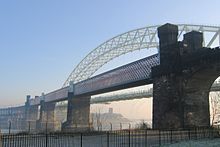Runcorn Railway Bridge
| Runcorn Railway Bridge | |
|---|---|

Runcorn Railway Bridge
|
|
| Coordinates | 53°20′48″N 2°44′18″W / 53.34676°N 2.73835°WCoordinates: 53°20′48″N 2°44′18″W / 53.34676°N 2.73835°W |
| Carries | Liverpool branch of the West Coast Main Line |
| Crosses |
River Mersey Manchester Ship Canal |
| Locale | Runcorn, Cheshire, England |
| Other name(s) | Ethelfleda Bridge Queen Ethelfleda Viaduct Britannia Bridge |
| Maintained by | Network Rail |
| Characteristics | |
| Design | double-web lattice girder |
| Material | wrought iron |
| Width | double track |
| Longest span | 305 feet (93 m) |
| Clearance below | 75 feet (23 m) |
| History | |
| Designer | William Baker |
| Opened | 1868 |
The Runcorn Railway Bridge, which is also known as the Ethelfleda Bridge or the Britannia Bridge, crosses the River Mersey at Runcorn Gap from Runcorn to Widnes in Cheshire, England. It was built for the London and North Western Railway (LNWR) to a design by William Baker, chief engineer of the railway company. It is recorded in the National Heritage List for England as a designated Grade II* listed building.
In 1846 the Grand Junction Railway Company obtained an Act of Parliament to build a bridge to cross Runcorn Gap. A time limit of 7 years was imposed. Shortly after obtaining the Act the Company amalgamated with others to form the London and North Western Railway. Other projects took precedence, the 7 years time limit passed, and so the powers to build the bridge lapsed.
In 1861 Parliamentary approval for a bridge was obtained by the LNWR as part of building a line from Aston, to the southeast of Runcorn where it joined the line from Crewe to Warrington at Weaver Junction, to the west of Widnes, where it joined the line from Warrington to Garston at Ditton Junction. The new line was 8.5 miles (14 km) long and reduced by more than 8 miles (13 km) the distance between Liverpool Lime Street and stations south of the River Weaver. Preparatory work commenced in 1863 and the first stone was laid in 1864. The bridge was completed by 1868 and on 21 May there was an introductory opening when the contractor's locomotive Cheshire drew 20 wagons over the bridge. It was formally opened for traffic on 10 October. The first goods traffic crossed it on 1 February 1869 and the first passenger train crossed on 1 April of that year.
...
Wikipedia
